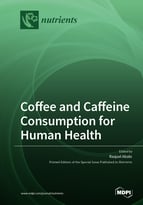Coffee and Caffeine Consumption for Human Health
A special issue of Nutrients (ISSN 2072-6643). This special issue belongs to the section "Phytochemicals and Human Health".
Deadline for manuscript submissions: closed (30 September 2020) | Viewed by 245017
Special Issue Editor
Interests: gastrointestinal motility; visceral pain; functional foods; cannabinoids; irritable bowel syndrome; nutraceuticals; enteric nervous system; brain–gut axis
Special Issues, Collections and Topics in MDPI journals
Special Issue Information
Dear Colleagues,
Coffee is one of the most popular and widely consumed beverages worldwide. Caffeine is present in coffee and many other beverages (tea, soft drinks) and is the most widely used central nervous system stimulant. However, caffeine and its metabolites may exert other relevant physiological effects on human health. Thus, preclinical, clinical, and epidemiologic studies on coffee, coffee derivatives, and caffeine effects on different aspects of human health are increasing. Evidence is accumulating suggesting that coffee drinking or caffeine supplementation may have a role in preventing cardiometabolic and endocrine disease, neuroinflammation, cancer, and even all-cause mortality. Other aspects are either less known or controversial, including the effects on the brain–gut axis, neurodevelopment, behavior, pain, muscle–skeletal health, skin or sexual function. Studies focusing on special populations (neonates, children, adolescents, athletes, elderly, pregnant and nonpregnant women), or interactions with other drugs and foods, are relatively scarce but of obvious interest. Other compounds present in coffee and other caffeinated food stuffs may affect caffeine´s physiological effects with a tremendous impact on health.
With the aim to offer a robust and critical updated view of the topic to the scientific community, any scientist or research group studying any aspect of coffee and caffeine effects on human health is welcome to contribute to this Special Issue entitled “Coffee and Caffeine Consumption for Human Health”. We welcome different types of manuscript submissions, including original preclinical and clinical research articles and up-to-date reviews (narrative and systematic reviews, as well as meta-analyses).
Prof. Raquel Abalo
Guest Editor
Manuscript Submission Information
Manuscripts should be submitted online at www.mdpi.com by registering and logging in to this website. Once you are registered, click here to go to the submission form. Manuscripts can be submitted until the deadline. All submissions that pass pre-check are peer-reviewed. Accepted papers will be published continuously in the journal (as soon as accepted) and will be listed together on the special issue website. Research articles, review articles as well as short communications are invited. For planned papers, a title and short abstract (about 100 words) can be sent to the Editorial Office for announcement on this website.
Submitted manuscripts should not have been published previously, nor be under consideration for publication elsewhere (except conference proceedings papers). All manuscripts are thoroughly refereed through a single-blind peer-review process. A guide for authors and other relevant information for submission of manuscripts is available on the Instructions for Authors page. Nutrients is an international peer-reviewed open access semimonthly journal published by MDPI.
Please visit the Instructions for Authors page before submitting a manuscript. The Article Processing Charge (APC) for publication in this open access journal is 2900 CHF (Swiss Francs). Submitted papers should be well formatted and use good English. Authors may use MDPI's English editing service prior to publication or during author revisions.
Keywords
- Coffee
- Caffeine
- Brain–gut axis
- Neurodevelopment
- Pain
- Cardiometabolic health







